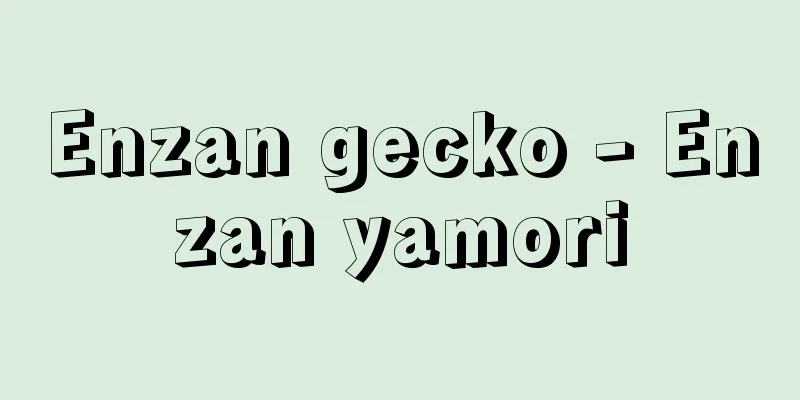Chinese Theatre

|
Peking Opera is well known among Chinese theater in Japan, but China, which boasts a long history and vast territory, also has over 300 other local traditional theater styles. Traditional theater styles are primarily distinguished by language (dialect) and melody. There are also spoken dramas, which are equivalent to Japan's modern drama. Traditional Chinese theater is dominated by the singing of actors, and takes the form of an opera that combines dialogue, gestures, and stage movements, and it can be said that there are many elements in common with traditional Japanese theater and other oriental theater. [Akira Denda and Hiroshi Seto] historyOrigin of the playIn China, the origin of theatrical performances is the song and dance of the primitive age. It started as a hunting and farming ritual in clan society, but in class society it became pure entertainment for emperors and aristocrats. Around the end of the Western Zhou Dynasty (771 BC), the Yu appeared, who were vassals to the aristocrats and specialized in providing entertainment. They are the origin of today's actors. During the Han Dynasty (202 BC-220 AD), the martial arts competition of the koto-gai (sumo wrestling), which developed from folk martial arts competitions, appeared, with a story of a magician fighting with a white tiger, such as "Yang Gong of the East Sea." During the Three Kingdoms and Six Dynasties period, this was combined with the song and dance of "Daimen (Lanling King)" and "Touyoujou (Dayouniang)." Although song and dance and koto-gai (sumo wrestling) were still the main focus, and narration of the plot was secondary, a step forward toward integration was seen. On the other hand, as the performance of Yu became stylized, Sangungi (Sangun-gi) was born, in which the two roles of Sangun and Sokotsu performed humorous and satirical dialogues. Among the gigaku masks in Japan's Shosoin Repository are those that match those of the Tsuina rituals in the middle reaches of the Yangtze River described in the 6th century "Keiso Saijiki". Various popular performing arts and spectacle arts, Hyakugi, from the Zhou and Han dynasties, were also introduced to Japan through Korea in the 6th and 7th centuries, and had a fundamental impact on the development of performing arts in our country as Sangaku. Kabuki (music and dance) was introduced a little later, in the latter half of the 7th century, and the above-mentioned three pieces have been handed down to the present day as Bugaku "Ryo-o", "Batou" and "Konju". After the Anshi Rebellion (755-763), the absolute dominance of aristocratic arts began to waver in the Tang Dynasty. Entertainers from the imperial court's teaching halls began to sell their art among the general public, and various arts were performed at temples along with secular lectures. These temple ceremonies became a place to adapt the arts cultivated in the imperial court to suit the tastes of the general public, and also contributed to the refinement of the arts of the general public. In the Song Dynasty, the scale of commerce expanded significantly, and entertainers were able to leave the teaching halls to make a living, and in Bianjing (Kaifeng), the capital of the Northern Song Dynasty (960-1127), a entertainment district lined with lanterns, which were theaters where various arts were shown, was established, called Gasha. Puppet theatre and martial arts were also performed there, but zatugeki became the most important of the various performing arts. This Song zatgeki (troupe of troupes) was more complex than the Jinjunxi (troupe of military opera), with more characters and, judging from the recorded plays, many of them were humorous plays depicting the state of society, with the lower classes of the townsfolk also appearing. After the Song dynasty traveled south, entertainers who remained in the north gathered in Yanshan (Beijing), the capital of the Jin dynasty (1115-1234), and formed the northern school of zatgeki (troupe of troupes), the Jin dynasty's "Yuanben" (troupe of troupes). The characters were basically the same as the Song zatgeki (troupe of troupes), but the plays, arranged in a set order, were linked in content, and the play was approaching a complete drama with multiple acts. [Akira Denda and Hiroshi Seto] Northern Opera and Southern OperaIn the 12th century, Song zaju and various performing arts began to split into north and south, and Northern zaju and Southern zaju began to form in the north and south, respectively, but those based on northern music are collectively called "Northern zaju" and those based on southern music are called "Nanqu." First, in the north, a new drama form called zaju appeared among the courtyard plays at the end of the Jin dynasty, and around 1200, the form starring a male and female lead, Matsu and Tan, arose in central and southern Shanxi. After the founding of Dadu (Beijing) in the Yuan Dynasty (1271-1368), it became the center of the flourishing of Northern Zaju, producing many writers such as Guan Hanqing, Ma Zhiyuan, and Bai Boku, as well as long works such as Wang Shifu's "Records of the Xixiang," and thus the first dramatic work in the history of Chinese literature, "Yuan Opera," blossomed. Due to the temporary relaxation of the control of Confucian ideology under the rule of a foreign ethnic group called the Mongols, and the fact that many of the writers were lower-class intellectuals with a consciousness relatively close to that of the common people, the broad realism of the works of this period has an aspect that even the later Ming and Qing dynasties' fantasy works could not surpass. After the fall of the Southern Song Dynasty (1127-1279), when waterway transportation via canals was restored, Yuan songs quickly spread to the cities in Jiangnan, and Hangzhou (Hangzhou) soon became its center. On the other hand, Nanxi developed from Wenzhou Zaju, a folk entertainment with relatively simple scripts that first appeared in the Wenzhou region at the end of the 12th century, and began to flourish in Lin'an (Hangzhou), the capital of the Southern Song Dynasty, almost in parallel with Bei Zaju in Dadu. After the unification of the Yuan dynasty, Nanxi developed in competition with Bei Zaju while interacting with it, and as Bei Zaju began to decline at the end of the Yuan dynasty and the beginning of the Ming dynasty, Nanxi gained momentum, producing many new works such as Gaoming's "Record of the Pipa," "Record of the Thorny Thorn," "Record of the White Rabbit," "Record of the Moon Pavilion (Record of the Ghost)," and "Record of Killing a Dog," which solidified the foundation for the next "Nanqu" period. [Akira Denda and Hiroshi Seto] Dramas in the Kunshan and Yiyang CavesIn the Ming Dynasty (1368-1644), Northern Zaju (Yuanqu) rapidly declined. Instead, Southern Opera (Nanqu) developed further and spread to various regions, forming local versions of the shengchun (theatre) drama. Kunshan, Haiyan, Yuyao, and Yiyang became the four major shengchun dramas, but in the Jiajing period (1522-1566), "Yiyang Cave" spread to various regions, giving birth to new shengchun drama types and absorbing the achievements of folk art to create the 'Koncho' drama. Meanwhile, during the Jiajing and Longqing eras (1522-1572), important reforms were carried out by Wei Liangfu and others, and with the publication of Liang Chenyu's (1519-1591) "The Record of the Enslaved," Kunsan Opera rapidly rose to prominence on the urban stage, displacing Haiyan Opera and claiming dominance. At this point, Kun and Yi Opera completely replaced the status of the former Northern Zaju, and from then until the beginning of the Qing Dynasty, the creation of "legendary" style scripts, which had evolved from Southern Opera, entered a period of unprecedented prosperity. A large number of works were published, and unprecedented new results were produced in theoretical works such as quzhu and theatrical theory. One of the representative works of these Ming songs is Tang Xianzu's "The Tale of Returning to the Soul at the Peony Pavilion." [Akira Denda and Hiroshi Seto] Qing Dynasty Provincial DramaFollowing the prosperity of Kun Shan Cave and Yiyang Cave Opera, the early 18th century to the mid-19th century was the period of the rise and prosperity of local folk drama. It inherited the popularization and development of Yiyang Cave Opera among the public since the end of the Ming Dynasty, and absorbed the artistic achievements of Kun Shan Cave Opera to innovate and add creativity to the existing drama form. It is characterized by a form that breaks through the form of stringing together different pieces of legendary melodies (qupai rentao) and focuses on rhythmic changes (banshi hen). Since the late Kangxi period (1662-1722), the new local drama "randan" Cave Opera appeared all over the country. With the development of the commodity economy, the regional and industry-specific halls built by merchant organizations in large and medium-sized cities in various regions became one of the important methods of professional performances by local theater troupes. Then, towards the end of the Qianlong period (1736-1795), the "Huabe" Randan various cunning plays and the "Elegant" Kunqu plays, which were considered the orthodox plays of the scholar-officials class, began to compete fiercely, with Gaoqong, Qinqong, and Huidiao competing for supremacy with the Elegant plays in the Beijing theatre. The victories of these Huabe plays in Beijing influenced the situation throughout the country, and the five major Seongqong schools were formed in the development of local theatre in various regions. In particular, the Bangzi and Pihuang schools developed the most, taking over the leading position from Kunshan cunning, creating a situation in which Randan was dominant and Opera art became more popular and richer and more diverse. Then, during the Jiaqing and Daoguang eras (1796-1850), new large-scale, comprehensive theatre styles were formed one after another in various regions through exchanges and mergers of various vocal chambers, and Peking opera was one of these, which was formed in the mid-19th century based on the combination of the Hui and Han styles in Beijing. [Akira Denda and Hiroshi Seto] Modern and contemporaryAfter the Opium Wars of 1840, the Jiangnan region, the birthplace of Kunqu actors, was devastated, and Kunqu fell into disuse. Peking opera was protected by the Qing dynasty and soon spread throughout the country due to the authority of court theater. It was introduced to Shanghai in 1867. Regional theater such as Sichuan Opera and Yue Opera also began to take shape in earnest during this period. At the end of the Qing Dynasty, under the influence of Liang Qichao (Ryō Keichō/Liang Qichao), who fled to Japan after failing in the Qing Dynasty reform movement, works on reform of theater such as "Records of Theater and Drama" (1903) were produced. As an emerging trading port, Shanghai's economic power led to the flourishing of commercial theater. Because commercial theater, by its very nature, required novelty in its plays, around 1890, performances of New Opera in Fashion began, a type of Peking opera in which contemporary costumes were used to tell the stories of the era. Student performances of theater also began in Shanghai in the early 20th century. Theory on theater reform permeated these movements, and Peking opera actors such as Wang Xiaojun (1858-1918) who dramatized political issues appeared. In 1908, a new stage was built by Xia Yue Jun (1878-1931) and others, which became the base for New Opera in Fashion. In June 1907, the Shunryu-sha, a group formed by Chinese students in Tokyo who had been influenced by the Shinpa school, staged "The Records of Black Slaves in Heaven," an adaptation of "Uncle Tom's Cabin." The reaction spread to Shanghai, where it was linked to student theater and political movements, and around the time of the Xinhai Revolution, wenmenxi (early spoken drama), a type of incomplete dialogue drama, was born. Wenmenxi reached its peak around 1914, overwhelmingly overpowering Peking opera, but was soon caught up in commercialism and went into decline. New Youth, launched in 1915, enthusiastically introduced Ibsen while strongly rejecting traditional theater. Under the influence of this new culture movement, spoken drama was born. The play Young Madam's Fan (an adaptation of Wilde's Lady Windermere's Fan), directed by Hong Shen (1894-1955) and performed by the Shanghai Drama Association in May 1924, is considered to be a milestone in the birth of spoken drama. It also gave birth to playwrights such as Tian Han. Thus, a dual structure of theatre was born in China, consisting of traditional theatre such as Peking opera, and spoken drama, which was influenced by modern Western theatre. In the late 1920s, talking theatre was influenced by Marxism, and proletarian theatre such as that of the Left Dramatists League became popular, but in 1935, due to the Kuomintang's oppression, the direction changed and national defence theatre, which united a wide range of theatre people, was advocated. During this period, the first professional talking theatre company, the China Travelling Theatre, was born, and masterpieces such as Cao Yu's "Thunderstorm" and Xia Yan's "Under the Roofs of Shanghai" were premiered here. In Peking opera, such great actors as Mei Lanfang, Zhou Xinfang, Cheng Yanqiu and Shang Xiaoyun appeared. With the start of the Second Sino-Japanese War in 1937, theater troupes toured around the country, performing anti-Japanese propaganda plays. The center of narrative drama moved to the temporary capital, Chongqing. Film production came to a halt during the war, and narrative drama in Chongqing flourished, with excellent works such as Guo Moruo's "Qu Yuan" appearing one after another, during what was called a golden age. The Shanghai Concession area was spared from the Japanese invasion and was called an isolated island, where narrative drama also flourished, with works such as "Shanghai at Night" by Yu Ling (1907-1997) being performed. With the outbreak of the Pacific War in 1941, the isolated island disappeared and it became difficult to perform narrative dramas, so some of the theater people moved into traditional theater, encouraging the formation of Yue Opera and Hu Opera. In Yan'an, an area under Communist control, emphasis was placed on theatre that served workers, peasants and soldiers after Mao Zedong's speech at the Yan'an Literary Symposium in 1942, leading to the creation of Yang operas such as "Brothers and Sisters Make Desert" in 1943 and a new opera, "White Haired Girl," in 1945. Reforms in Peking opera also began in Yan'an, and new historical dramas such as "Forced to Ascend to Liangshan" were created. After the founding of the People's Republic of China (1949), the first priority was the reform of traditional theater. The basic policy was set out in the "Instructions for Drama Reform Work" issued by the Ministry of Culture on May 5, 1951. The repertoire was streamlined, and relics of the feudal system of theater companies were removed, and some plays, such as "The Battle of the Dead," were banned for being obscene. With regard to drama, national theater companies such as the Beijing People's Art Theater and the Central and Shanghai Theater Academy were established, and the arts were regularized and specialized, and the Stanislavski system was widely studied. However, in the name of realism, the emphasis was placed on serving politics, and few excellent works were produced, with the exception of "The Tea House," written by Lao She and directed by Jiao Juyin (1905-1975), which was performed in 1958. For traditional theater such as Peking opera, the policy was to allow the coexistence of three types of theater: traditional plays, new historical dramas, and modern dramas. However, after 1964, performances of anything other than modern dramas were no longer permitted. This trend reached its peak during the Cultural Revolution in 1966, when modern revolutionary Peking operas such as "Take the Tiger Mountain" and "Red Lantern" that depicted the political struggles of the Communist Party were designated as model revolutionary plays, and other local plays were forced to perform them. The originality of huaju was also denied. After the end of the Cultural Revolution in 1976, huahua dramas actively addressed social issues such as the aftereffects of the revolution, and were very well received by audiences. Classical Peking opera was also revived after 1978. However, as the political excitement that followed the Cultural Revolution subsided and television became widespread, audiences for both huahua and traditional theater dropped sharply in the 1980s, creating a crisis for theater. To overcome this situation, huahua dramas gave rise to two new movements: a tendency to return to the essence of huahua dramas by depicting characters with individuality, such as in Jin Yun's (1938-) "The Nirvana of Husband Dog," and experimental theater, which aims to overcome the theatrical form of huahua itself, such as in Gao Xingjian's "Bus Stop." Experimental theater can also be seen to be influenced by Western avant-garde theater. Small theaters began to be established and directors began to be emphasized, with directors such as Lin Zhaohua (1936-), who achieved success in both experimental and realistic theater, appearing. Various foreign plays, such as Miller's Death of a Salesman and Beckett's Waiting for Godot, were translated and performed. In the 1990s, with the progress of market economics, private independent theater groups were born, and directors such as Meng Jinghui (1965-) and Mo Sen (1963-) appeared. Reforms in the theater group system also progressed, and in Beijing, audiences began to return to theater around 1999, but unstable factors such as a lack of excellent playwrights have not yet been overcome. In Taiwan, after 1949, the Kuomintang government protected Peking opera under the name of national opera, and for a long time, huahua drama was produced as political propaganda drama called anti-communist and anti-Russian drama. After Wu Jingji's (1935-) production of "The New Pack of Pearls" in 1980, small theater productions became popular and directors such as Lai Shengchuan (1954-) appeared. In the 1990s, exchanges with mainland China have progressed. Since 1949, Hong Kong has suffered a long period of artistic stagnation, known as a cultural desert, but with the city's economic growth, the public theatre company Hong Kong Drama Company was established in 1977, and works such as A Date with Spring, written by Du Kuo Wai and directed by Ko Tien Nung, which was performed in 1992, were well received. Since the 1980s, experimental theatre has also been performed actively. [Hiroshi Seto] Theater/StageThe Heiraku Theater in Chang'an, which appears in Zhang Heng's Xijing Fu of the Later Han Dynasty, is the first record of a permanent square theater, and tented seating was built for imperial visits. The construction of a stage appears to have been initiated in the Tang Dynasty, after the appearance of hut-style seating for VIP guests. The Dunhuang mural Pure Land Transformation shows a low railing around the stage, and this form has been passed down through the Song Dynasty's "Rodai" and the "Kouran" railings of Bianjing and Lin'an to modern times. Around the end of the 11th century, the stage changed from a conventional style in which the audience was surrounded on all four sides to a style in which one side was closed off to create a back stage behind the stage, with a curtain separating the stage from the front stage where the actors performed, and the Kimondo (paths of evil spirits) for the actors to enter and exit the stage on either side. The Yuan dynasty's Du Shanfu's prose "Inakamono no Shibaishirazu" (The Village Unaware of Railings) vividly depicts the appearance of railings in an interesting way. Even before the railings in cities, roofed "dance pavilions" for temple ceremonies were built in rural areas, which eventually developed into "temple platforms" for theatrical performances. The theaters and stages of the Ming and Qing dynasties were basically an extension of the Song and Yuan dynasties, but they showed developments that far surpassed those of the previous era in both quality and quantity, such as temple platforms, private residences, and court stages. The use of kouran as a permanent theater in cities declined during the Ming dynasty, but was replaced by "Gien" (theater gardens) where plays were performed on the floor, under the names of liquor houses and tea gardens, and in the Qing dynasty, these began to have stages equipped with lighting and other facilities. This separation of dining and theater was only achieved after the birth of modern Western-style theaters in the late Qing dynasty, and the first Western-style framed stage with an open side was the "New Stage," built in Shanghai in 1908 after learning from the Shintomi-za Theater in Japan. For 800 years, from the Song and Yuan dynasties to the end of the Qing dynasty, the mainstream theater stage was one that opened on three sides, which was a form that was originally suited to traditional Chinese theater. After the New Stage, traditional theaters gradually fell into disuse, and Western-style theaters became mainstream. After the founding of the People's Republic of China, theaters specializing in spoken drama, such as the Capital Theater (1956), were built one after another in various places. Along with China's economic growth, state-of-the-art theaters such as the Shanghai Grand Theater (1998), which has three theaters, a large theater, a medium-sized theater, and a small theater, appeared in the 1990s. Taiwan also has the National Chiang Kai-shek Cultural Center (1987), which has a variety of theaters for drama and music. [Akira Denda and Hiroshi Seto] Characteristics of Chinese TheatreAs Wang Wang Wei called it, traditional Chinese theater cannot be separated from music. However, unlike Western opera, which is a pure form of theater with absolute dominance of musical elements, it also combines singing, thinking, acting, and dancing, and has a high degree of comprehensiveness that is a fusion of song, dance, comedy, and chanting in its origins, which is its first characteristic. The second characteristic is a relatively large degree of virtuality, distanced from reality. Unlike the three unities of Western theater, the stage has free, flowing space and time, not fixed. One revolution around the stage travels a hundred thousand miles, and dawn breaks to the sound of the drum. When and where a character speaks, the stage becomes that space at that moment. Starting from simple staging under poor material conditions, the subsequent development of Chinese theater did not move in the direction of realism, likely due to the aesthetic tradition that seeks to capture the true essence of an object in the "spirit" of its atmosphere, rather than in the "form" of its realistic appearance. The third characteristic is stylization. Each action, such as opening a door or window, riding a horse or boat, is basically performed according to a fixed pattern. This is the beautification and dance-like transformation of everyday actions, which brings rhythm to the performance. This stylization extends from the script format to the clearly divided roles such as Sheng (leading role), Dan (female role), Jing (hero, enemy role), Chu (clown), and Matsu (supporting role), to the musical vocal cavity, the unique makeup called Renpu, and the costumes, and more beautiful and unique colors are created through exaggeration and decorative deformation. These characteristics of traditional Chinese theater are collectively called xieyi. Since the birth of narrative theater in the 1920s, traditional theater and narrative theater based on realistic forms such as the Stanislavski system have coexisted, but there is also interaction between the two, bringing new elements to each type of theater. [Akira Denda and Hiroshi Seto] ``Chinese Drama and Bairanpo'' by Murata Karasue (1919, Genbunsha) ▽ ``Chinese Drama and Name Yu'' by Kenichi Hatano (1925, Shinsakusha) ▽ ``China's History of Early Modern Songs'' by Masahiro Aoki (1930, Kobundo) ▽ ``Introduction to Yuanjin Theater'' by Masaaki Aoki (1937, Kobundo) ▽ ``Introduction to Peking Opera'' by Tokki Ando (1939, Nippon Koronsha) ▽ ``Taikan of China Theater'' by Kenichi Hatano (1940, Daito Publishing) ▽ ``Research on Genzangeki'' by Kojiro Yoshikawa (1948, Iwanami Shoten)'' ▽ “Chinese New Drama” written by Karashima Hou (1948, Shoheido) ▽ “Peking Opera” written by Shigetoshi Kawatake et al. (1956, Awaji Shobo)” ▽ "Peking Opera Handbook" by Takeuchi Yoshio, Tsukamoto Sukeru, and Masuya Jisaburo (1956, San-ichi Shobo)" ▽ "Peking Opera Reader" edited and published by The Asahi Shimbun Company (1956) ▽ "Complete Works of Classical Chinese Literature 33: Plays" edited by Aoki Masaji (1959, Heibonsha) ▽ "Study of Ming Dynasty Playwrights" by Yagisawa Hajime (1959, Kodansha) ▽ "Old Country, New Art: Records of a New Japanese Theater Company's Visit to China" edited by Ozaki Koji and Kinoshita Junji (1961, Chikumashobo) ▽ "Complete Works of Classical Chinese Literature 52 & 53: Plays" edited by Tanaka Kenji (1970, Heibonsha) ▽ "Research on Chinese Drama and Theatre" by Iwaki Hideo (1973, Sobunsha) ▽ "Rebellious Art" edited and published by The Asahi Shimbun Company (1972) ▽ Hatano Taro, Research on the History of Chinese Literature: A Study of Novels and Dramas (1974, Ohfusha) ▽ Ikeda Daigo, translated and annotated by Tanaka Kenji, Five Types of Yuan Opera (1975, Heibonsha) ▽ Iwata Naoji, Hikasa Yoshihisa and Moroi Joji (eds.), Chinese Drama After the Cultural Revolution (1979, Tabata Shoten) ▽ Sugiura Kohei, Wada Jun and Matsumori Tsutomu (eds.), A Hundred Flowers of Peking Opera with commentary by Li Bo (1980, Heibonsha) ▽ Tanaka Kazunari, Research on Chinese Ritual Drama (1981, University of Tokyo Press) ▽ Tanaka Kazunari, Chinese Lineages and Drama: The Correlation Structure of Ritual Organizations, Rituals and Drama in Southern Chinese Lineage Societies (1985, University of Tokyo Press) ▽ Iwaki Hideo, Research on Classical Chinese Drama (1986, Sobunsha) ▽ "Studies on Chinese Village Rituals - The Environment of Regional Drama" by Tanaka Kazunari (1989, University of Tokyo Press)" ▽ "Thoughts on Modern Chinese Drama" by Matsubara Tsuyoshi (1991, Shinhyoron) " ▽ "Contemporary Drama in China" by Seto Hiroshi (1991, Kobun Publishing)" ▽ "Collection of Essays on Chinese Classical Drama - Commemoration of the Lifetime Achievement of Dr. Tanaka Kenji" edited by Dr. Tanaka Kenji Memorial Collection Publishing Committee (1991, Kokushoin)" ▽ "Studies on Chinese Shamanic Drama" by Tanaka Kazunari (1993, University of Tokyo Press)" ▽ "Collection of Contemporary Chinese Drama, Volumes 1-4 edited by Huajurensha's Contemporary Chinese Drama Collection Editorial Committee (1994-2001, Bansei Shobo)" ▽ "Peking Opera and the Chinese" by Hizumi Katsuo (1995, Shinchosha)" ▽ "History of Chinese Theatre" by Tanaka Kazunari (1998, University of Tokyo Press)" ▽ "A Complete Guide to Appreciating Peking Opera" by Zhao Xiaoqun and Mukoda Kazuhiro (1998, Kobun Publishing)" ▽ "The Shanghai Stage" by Ito Shigeru (1998, Suishobo)" ▽ "A Study of Mito Komon's "Wanderings"" by Jin Hainan (1999, Shinjinbutsu Oraisha)" ▽ "Chinese Theatre in the Twentieth Century - An Overview of the History of Chinese Drama" by Seto Hiroshi (1999, Toho Shoten) ▽ "Introduction to Peking Opera" by Lu Daming (2000, Ongaku No Tomosha) ▽ "Dramas of the Ming and Qing Dynasties - Representations of the Jiangnan Clan Society" by Tanaka Kazunari (2000, Sobunsha)" ▽ "Chinese Propaganda Art - Revolutionary Memories in the Mao Zedong Style" by Maki Yoichi, Matsuura Tsuneo, and Kawada Susumu (2000, Iwanami Shoten)" ▽ "An Introduction to the History of Dramatic Drama in the Ming and Qing Dynasties - A Study of Tang Xianzu's "The Peony Pavilion Return to the Soul" by Negayama Toru (2001, Sobunsha)" ▽ "Research on Classical Chinese Drama" by Komatsu Ken (2001, Kiko Shoin) ▽ "Peking Opera - Portraits of Actors in a 'Political Country'" by Kato Toru (2002, Chuokoron-Shinsha) ▽ "Invitation to Peking Opera" by Lu Daming (2002, Shogakukan)" ▽ "History of Chinese Drama" by Xu Muyun (1938, World Bookstore)" ▽ "An Initial Exploration of the Peking Opera Drama Index" edited by Tao Junqi (1963, China Drama Publishing House)" ▽ ``Mainland Chinese Dramatic Reform 1942-1967'' written by Zhao Cong (1969, Chinese University of Hong Kong)' ' ▽ ``Dictionary of Chinese Drama Lyrics'' (1981, Shanghai Dictionary Publishing House) edited by the Shanghai Institute of Arts and Chinese Dramatists Association Shanghai Branch'' ▽ ``China Encyclopedia of Dramatic Acrobatics'' (1983, China Encyclopedia Publishing House)'' ▽ ``History of Chinese Drama'' by Wu Ruo and Jia Yisun (1985, Taiwan, Cultural Construction Committee of the Executive Yuan) ▽ ``Historical History of Modern Chinese Drama Education'' (edited by Yan Fengwu) (1986, East China Normal University Press) ▽ ``Historical History of Modern Chinese Drama'' (edited by Chen Baijun and Dong Jianzhu (1989, China Drama Publishing House)) ▽ “Dictionary of Peking Opera Opera Items” edited by Zeng Bairong (1989, China Opera Publishing House) ▽ ``Chinese Encyclopedia/Drama'' (1989, China Encyclopedia Publishing House) ▽ ``Complete History of Chinese Drama'' edited by Ge Yihong (1990, Culture and Arts Publishing) ▽ ``Chinese Drama History Draft'' by Bai Bin (1991, Shanghai Translation Publishing Company) ▽ ``Comprehensive History of Chinese Drama'' by Zhang Geng and Guo Hancheng, 2nd edition (1992, China Drama Publishing House)'' ▽ ` `Comparative History of Modern Chinese Drama'', edited by Sang Tamoto (1993, Culture and Arts Publishing Company)' ' ▽ ``Outline of Research on the History of Chinese Drama'' by Sang Tamoto and Jiao Shangzhi (1993, Tianjin Antique Publishing Company)'' ▽ “Modern Chinese Drama by West Chao” by Ma Sen (1994, Taiwan, Shulin Publishing Co., Ltd.) ▽ “Illustrated History of Chinese Drama by Liao Kuan (1996, Henan Educational Publishing Company)” ▽ "History of Chinese Peking Opera," edited by Beijing Municipal Arts Research Institute and Shanghai Arts Research Institute (1999, China Drama Publishing House) [Reference item] | | | | | |Nanqu|Haiyue | | | | | | | | | |Source: Shogakukan Encyclopedia Nipponica About Encyclopedia Nipponica Information | Legend |
|
中国の演劇は日本では京劇がよく知られているが、長い歴史と広い国土を誇る中国にはそのほかにも300を超える数多くの地方伝統演劇の劇種がある。伝統演劇の劇種は、おもに言語(方言)とメロディーによって区別される。また、日本の新劇に相当する話劇も上演されている。中国の伝統演劇は俳優の歌唱を軸に、台詞(せりふ)、しぐさ、立回りを組み合わせて歌劇の形態をとるのが主流であり、日本の伝統演劇をはじめとする東洋の演劇に共通する要素が多いといえよう。 [傳田 章・瀬戸 宏] 歴史戯曲の起源中国においても演劇的なものの起源は原始時代の歌舞である。それは氏族社会の狩猟や農耕の儀式として始まったが、階級社会に入ると帝王、貴族のための純粋の娯楽となっていった。西周の末年(前771)ごろには貴族に隷属して娯楽の提供を専業とする優(ゆう)が出現する。今日の俳優の起源である。漢代(前202~後220)にはすでに『東海黄公(とうかいこうこう)』のように術士と白虎(びゃっこ)の格闘という物語をもった、民間の武術競技から発展した角觝戯(かくていぎ)が現れ、三国六朝(りくちょう)にはこれと結合して『大面(だいめん)(蘭陵王(らんりょうおう))』『踏揺娘(とうようじょう)』などの歌舞ができる。まだ歌舞や角觝(相撲)が主で、筋を語るのは従であるが、総合化への一歩前進がみられる。一方、優の演技が様式化すると、参軍、蒼鶻(そうこつ)の二つの役柄でおもに対話で滑稽(こっけい)と風刺を演ずる参軍戯(さんぐんぎ)が生まれた。日本の正倉院の伎楽面には6世紀の『荊楚歳時記(けいそさいじき)』が記す長江中流域方面の追儺(ついな)のそれに合致するものがある。周漢以来のもろもろの大衆芸能や見せ物芸の百戯(ひゃくぎ)も、6、7世紀に朝鮮を通って日本に伝わり、散楽としてわが国の芸能の発展に本質的な影響を与えた。歌舞はやや遅れて7世紀後半から伝来し、上述の3曲はそれぞれ舞楽『陵王(りょうおう)』『抜頭(ばとう)』『胡飲酒(こんじゅ)』として今日まで伝承されている。 唐代も安史(あんし)の乱(755~763)を過ぎると貴族文芸の絶対支配に揺らぎがみえるようになる。宮廷教坊(きょうぼう)の芸人たちも市民のなかに出て芸を売るようになり、寺院で俗講(ぞくこう)とともに諸芸能が演じられた。この廟会(びょうかい)が宮廷で育った芸術を市民の趣味に沿ったものに改造する場となり、市民の芸術の洗練にも作用した。宋(そう)代に入ると商業規模は著しく拡大して、芸人たちはもはや教坊を離れて生活ができるようになり、北宋(960~1127)の都汴京(べんけい)(開封(かいほう/カイフォン))にはそれぞれの芸能を見せる劇場である勾欄(こうらん)の建ち並ぶ盛り場「瓦舎(がしゃ)」ができる。そこでは人形劇傀儡戯(かいらいぎ)や角觝競技も演じられたが、「雑劇(ざつげき)」が各種芸能のうちもっとも重要なものとなった。 この宋雑劇(そうざつげき)は、参軍戯より複雑化しており、役柄が増え、記録された演目からみると、市井の下層民も登場する世態を写した滑稽劇が多いようである。宋朝南渡後、北に残留した芸人が金(1115~1234)の都燕山(えんざん)(北京(ペキン))に集まって北方派の雑劇、金(きん)の「院本(いんぽん)」を形成する。役柄などは宋雑劇と基本的に同じだが、一定の順序で並べられる演目が内容的に連係するものとなっているなど、複数の幕を並べる完全な演劇に近づいている。 [傳田 章・瀬戸 宏] 北雑劇と南戯12世紀に入って、宋雑劇および各種の演芸が南北に分かれて分流を始め、北雑劇(ほくざつげき)と南戯(なんぎ)がそれぞれに北方と南方で形成を開始するが、北方系の音楽を基調とするものを総称して「北曲」、南方系のそれを「南曲」ともいう。まず北方では金代末葉に院本のなかに雑劇という新しい戯曲形式が出現し、これが前身となって1200年ごろに男女の主役、末(まつ)と旦(たん)の主演の形が山西中南部一帯におこった。元(1271~1368)の大都(だいと)(北京)建都以後、それが北雑劇盛行の中心となり、関漢卿(かんかんけい)、馬致遠(ばちえん)、白樸(はくぼく)ら多数の作家が出て、王実甫(おうじっぽ)の『西廂記(せいそうき)』のような長編も生まれ、中国文学の歴史に初めての劇文学「元曲(げんきょく)」の花を咲かせた。モンゴルという異民族支配のもとでの一時的な儒教イデオロギー支配の弛緩(しかん)や、作家たちの多くが下層の知識人で比較的庶民層に近い意識をもっていたことなどがあって、この時期の作品のもつ幅広いリアリズムは後の明(みん)・清(しん)の伝奇(でんき)も超えられない一面をもっている。南宋(なんそう)(1127~1279)滅亡後、運河の水路交通が回復すると、元曲は急速に江南の都市にも流布し、まもなく杭州(こうしゅう/ハンチョウ)がその中心となった。 一方、南戯は12世紀末、初め温州地方の民間演芸として比較的簡単な脚本で演じられていた温州雑劇が発達したもので、大都の北雑劇にほぼ並行して南宋の都臨安(りんあん)(杭州)で盛行し始める。元統一後は北雑劇と交流しつつ競争的に発展し、元末明初に至って北雑劇が衰退に向かうとかわって勢いを増し、高明(こうめい)の『琵琶記(びわき)』をはじめ『荊釵記(けいさき)』『白兎記(はくとき)』『拝月亭(幽閨記(ゆうけいき))』『殺狗記(さっくき)』など新作が数多くできて、次の「南曲」の時代の基礎を固めた。 [傳田 章・瀬戸 宏] 崑山腔と弋陽諸腔の劇明代(1368~1644)に入って北雑劇(元曲)は急速に衰微する。かわって南戯(南曲)がいっそうの発展をみせ、各地に広がってそれぞれの土地にあった声腔(せいこう)(曲調)の劇種を形成していく。崑山(こんざん)、海塩(かいえん)、余姚(よよう)、弋陽(よくよう)が四大声腔となるが、嘉靖(かせい)年間(1522~1566)に入ると、「弋陽腔(よくようこう)」が各地に伝わって新しい声腔の劇種を生み、民間芸術の成果を吸収して滾調(こんちょう)を創造する。一方、「崑山腔(こんざんこう)」(崑曲(こんきょく))は嘉靖・隆慶(りゅうけい)年間(1522~1572)に魏良輔(ぎりょうほ)らが重要な改革を進め、梁辰魚(りょうしんぎょ)(1519―1591)の『浣紗記(かんさき)』が出ると、都市の舞台で崑山腔が急速に興隆し、海塩腔(かいえんこう)を駆逐して覇を唱える。ここに至って崑、弋両腔がかつての北雑劇の地位に完全にとってかわり、以後清(しん)初まで南戯から発展進化した「伝奇」形式の脚本創作が空前の繁栄の時期を迎えた。作品が大量に刊行され、曲律や劇論など理論著作の面でもかつてない新しい成果が生まれた。これら明曲(みんきょく)の代表作に湯顕祖(とうけんそ)の『牡丹亭還魂記(ぼたんていかんこんき)』がある。 [傳田 章・瀬戸 宏] 清代地方劇崑山腔と弋陽諸腔劇盛行の後を継いで、18世紀初めから19世紀なかばまで民間地方劇の興起と盛行の時期となる。明末からの弋陽諸腔の民間での流布、発展を受け継ぎ、崑山腔の芸術成果をも吸収して既存の戯曲形式を革新して創造を加えたもので、伝奇のメロディーの異なる曲を連ねる(曲牌連套(きょくはいれんとう))形式を突破した、リズムの変化(板式(ばんしき)変化)を主とする形式にその特徴がある。康煕(こうき)年間(1662~1722)後期以来、全国各地に新興の地方劇である「乱弾(らんだん)」諸腔が出現する。商品経済の発展に伴い各地の商人組織が大・中都市につくった地域・業種別の会館が、地方劇団の職業公演の重要な方式の一つとなった。 ついで乾隆(けんりゅう)年間(1736~1795)末葉から、この「花部(かぶ)」乱弾諸腔と士大夫(したいふ)層が正統とする「雅部(がぶ)」崑曲の激しい競争の局面となり、北京の劇壇で前後して高腔(こうこう)、秦腔(しんこう)、徽調(きちょう)が雅部と覇を競う。北京でのこれら花部の勝利は全国の形勢に影響を与え、各地の地方劇種の発展のなかで五大声腔系統が形成された。とりわけ梆子(ほうし)、皮黄(ひこう)両系統がもっとも発達して、崑山腔と主導地位を交替し、乱弾優勢、戯曲芸術のよりいっそうの大衆化、豊富多彩化の状況をつくりだした。そして嘉慶(かけい)・道光(どうこう)年間(1796~1850)、各声腔の交流と合流によって各地に相次いで新しい総合性の大型劇種が形成されていくが、京劇(きょうげき)もその一つで、徽調と漢調(かんちょう)の北京での結合が基礎となって、19世紀なかばに形成される。 [傳田 章・瀬戸 宏] 近現代1840年のアヘン戦争以後、崑曲俳優の産出地である江南地方が荒廃し、崑曲は廃れた。京劇は清朝朝廷の保護を受け、まもなく宮廷演劇の権威により全国に広がった。上海(シャンハイ)には1867年に伝わった。川劇(せんげき)、粤劇(えつげき)などの地方劇もこの時期に本格的に形成された。 清末には、清朝改革運動に失敗して日本に逃れた梁啓超(りょうけいちょう/リヤンチーチャオ)らの影響で、「観戯記」(1903)などの演劇改良論が生まれた。 新興の貿易港である上海では、その経済力により商業演劇が盛んになった。商業演劇はその性格上新奇な劇を求めたため、1890年ごろより同時代の衣装を用いてその時代の話を演じる京劇である時装新戯(じそうしんぎ)が上演され始めた。学生による演劇上演も、上海で20世紀初頭から始まった。演劇改良論はこれらの動きに浸透し、汪笑儂(おうしょうのう/ワンシィヤオノン)(1858―1918)など政治問題を劇化する京劇俳優も現れた。1908年には夏月潤(かげつじゅん/シヤユエルン)(1878―1931)らによって新舞台がつくられ、時装新戯の拠点となった。 東京で新派の影響を受けた中国人留学生によって結成された春柳社が、1907年6月に『アンクル・トムの小屋』を脚色した『黒奴籲天録(こくどゆてんろく)』を上演した。その反響が上海に伝わり、学生演劇や政治運動と結び付いて不徹底な台詞劇である文明戯(早期話劇)が辛亥革命(しんがいかくめい)前後に生まれた。文明戯は1914年ごろ最盛期を迎え京劇を圧倒する勢いを示したが、まもなく商業主義に絡め取られて衰退した。1915年創刊の『新青年』はイプセンを熱狂的に紹介するとともに、伝統演劇を強く否定した。この新文化運動の影響で話劇が生まれた。1924年5月上海戯劇協社が上演した洪深(こうしん/ホンシェン)(1894―1955)演出『若奥様の扇』(ワイルド作『ウィンダミア卿(きょう)夫人の扇』翻案)が話劇成立の指標とされている。田漢(でんかん/ティエンハン)などの劇作家も生まれた。こうして、中国では京劇など伝統演劇と西洋近代劇の影響を受けて成立した話劇の演劇二重構造が生じた。 1920年代後半、話劇はマルクス主義の影響を受け、左翼戯劇家連盟などのプロレタリア演劇が盛んになったが、国民党の弾圧により1935年には方向転換して広範な演劇人と団結する国防演劇が提唱された。この時期には、最初の職業話劇団である中国旅行劇団が生まれ、曹禺(そうぐう/ツァオユー)『雷雨』や夏衍(かえん/シヤイエン)『上海の屋根の下』などの名作も初演されている。京劇では、梅蘭芳(メイランファン)、周信芳(しゅうしんほう/ジョウシンファン)、程硯秋(ていけんしゅう/チョンイエンチウ)、尚小雲(しょうしょううん/シヤンシィアオウィン)などの名優が現れた。 1937年日中戦争の開始とともに、演劇隊が各地を巡回し抗日宣伝劇を上演した。話劇の中心は臨時首都の重慶(じゅうけい/チョンチン)に移った。戦争で映画制作が途絶えたこともあり、重慶の話劇は大いに栄え郭沫若(かくまつじゃく/クオモールオ)の『屈原(くつげん)』など優れた作品が続出し黄金時代とよばれた。上海の租界地区は日本の侵攻を免れ孤島とよばれ、ここでも話劇が栄え于伶(うれい/ウィーリン)(1907―1997)の『夜の上海』などが上演された。1941年太平洋戦争勃発(ぼっぱつ)で孤島が消滅して話劇上演が困難になり、演劇人の一部は伝統演劇に流入して、越劇(えつげき)、滬劇(こげき)などの形成を促した。共産党支配地区の延安では、1942年の延安文芸座談会での毛沢東(もうたくとう/マオツォートン)講話以後労働者・農民・兵士に奉仕する演劇が強調され、1943年には『兄妹開荒(けいまいかいこう)』などの秧歌劇(おうかげき)が、1945年には新歌劇『白毛女(はくもうじょ)』がつくられた。延安では京劇改革も始まり、『逼(せま)られて梁山(りょうざん)に上がる』などの新編歴史劇がつくられた。 中華人民共和国建国(1949)後は、まず伝統演劇改革が強調された。その基本方針は文化部が1951年5月5日に出した「戯曲改革工作についての指示」に示されている。演目の整理や劇団封建遺制の除去が行われ、『活捉(かっそく)』など一部の演目が猥雑(わいざつ)などの理由で上演を禁止された。話劇は、北京人民芸術劇院など国立劇団の創設や中央・上海戯劇学院の設立が行われ、正規化・専門化が進み、スタニスラフスキー・システムが大いに学習された。しかし演劇とくに話劇はリアリズムの名のもとに政治への奉仕が強調され、優れた作品は1958年上演の老舎(ろうしゃ/ラオショー)作、焦菊隠(しょうきくいん/ジャオジィウイン)(1905―1975)演出『茶館』を例外としてほとんど生まれなかった。京劇など伝統演劇は、伝統演目、新編歴史劇、現代劇の三者併存の方針がとられたが、1964年以降は現代劇以外の上演は許されなくなった。 この傾向は1966年からの文化大革命で頂点に達し、京劇は『智取威虎山』『紅灯記』など共産党の政治闘争に取材した革命現代京劇が革命模範劇に指定され、ほかの地方劇もその上演を強制された。話劇もその独自性が否定された。 1976年の文革終結以後、話劇は文革の後遺症などの社会問題を積極的に取り上げ、大いに観客の歓迎を受けた。古典京劇も、1978年以後復活した。しかし、文革直後の政治的興奮の沈静化とテレビの普及によって、話劇、伝統演劇を問わず観客は1980年代に入って激減し演劇の危機が生じた。話劇では、この状況を克服するため、錦雲(きんうん/ジンウィン)(1938― )作『犬だんなの涅槃(ねはん)』など個性をもった人物を描き話劇の本質に立ち返ろうとする傾向と、高行健(こうこうけん/ガオシンヂエン)『バス停』など話劇という演劇形式自体の克服を目ざす実験演劇の二つの新しい動きが生まれた。実験演劇には西洋前衛演劇の影響もみられる。小劇場演劇の開始や演出家の重視も始まり、実験演劇と写実系演劇の双方に成果をあげた林兆華(りんちょうか/リンジャオフア)(1936― )などの演出家が現れた。ミラー作『セールスマンの死』、ベケット作『ゴドーを待ちながら』などさまざまな外国演劇が翻訳上演された。 1990年代に入ると市場経済化の進展のなかで私的な自立演劇集団が生まれ、孟京輝(もうけいき/モンジンフイ)(1965― )、牟森(ぼうしん/モウセン)(1963― )などの演出家が出現した。劇団体制改革も進み、北京では1999年ごろから観客がふたたび演劇に戻り始めたが、優れた劇作家の欠乏など不安定要素はまだ克服しきれていない。 台湾では、1949年以後国民党政府によって、京劇は国劇の名で政府の保護を受け、話劇は反共抗俄劇(はんきょうこうがげき)とよばれる政治宣伝劇が長く行われた。1980年の呉静吉(ごせいきつ/ウージンジー)(1935― )演出『荷珠新配(かじゅしんぱい)』以後、小劇場演劇が盛んになり頼声川(らいせいせん/ライションチュアン)(1954― )などの演出家が現れた。1990年代に入って、中国大陸との交流が進んでいる。香港(ホンコン)では、1949年以降文化砂漠とよばれる芸術不振状況が長く続いたが、香港の経済成長に伴い1977年には公立劇団の香港話劇団がつくられ、1992年上演の杜国威(とこくい/ドゥーグォウェイ)作、古天農(こてんのう/グーティエンノン)演出『春とのデート』などが歓迎を受けた。1980年代以降は実験演劇も盛んに上演されている。 [瀬戸 宏] 劇場・舞台後漢の張衡(ちょうこう)の『西京賦(せいけいのふ)』にみえる長安の平楽(へいらく)は常設の角觝戯劇場広場の最初の記録で、皇帝の行幸にはテント張りの座席がつくられた。演技台の建築は、上客用の小屋掛け客席の出現よりのち、唐代に入ってからのことのようで、敦煌(とんこう)壁画『浄土変(じょうどへん)』では台の周囲に低い欄干をつけているが、この形は宋代の「露台(ろだい)」、汴京(べんけい)や臨安の「勾欄(こうらん)」を経て近代まで受け継がれる。およそ11世紀の末には、それまでの観客が四方を囲んでいた形から、一方を閉じて舞台裏の後台(こうだい)をつくり、演技をする前台(ぜんだい)との間を幕などで仕切ってその左右に俳優の登退場口の鬼門道(きもんどう)をあけるものに移行する。元の杜善夫(とぜんふ)の散曲『荘家不識勾欄(いなかもののしばいしらず)』が勾欄のようすを活写しておもしろい。都市の勾欄より早く、農村には廟(びょう)祭用の屋根付きの「舞亭(ぶてい)」ができ、やがてそれが演劇のための「廟台(びょうだい)」に発展する。明・清の劇場、舞台は基本的には宋・元の形態の延長であるが、廟台、個人の邸宅や宮廷の舞台など質・量ともに前代をはるかにしのぐ発展をみせる。都市の常打ち劇場としての勾欄は明代には衰微するが、かわって酒館、茶園などの名でフロアで芝居を見せる「戯園(ぎえん)」の形が現れ、清代に入るとそれが照明設備などを備えた舞台を設けるようになる。この飲食と観劇とが分離されるのは、清末西欧型の近代的な劇場の誕生以後のことで、一方に開いた西欧型の額縁(がくぶち)型舞台は、1908年上海で日本・新富座に学んでつくられた「新舞台」が初めである。宋・元より清末までの800年間、演劇の舞台は三方に開いた形が主流であったが、それは中国の伝統演劇に本来的に合致した形態であった。新舞台以後、旧来の劇場はしだいに廃れ、西欧式劇場が主流になった。中華人民共和国建国以後は、話劇の専門劇場である首都劇場(1956)などが各地で続々と建設された。中国の経済成長に伴い、1990年代には大劇場・中劇場・小劇場の3劇場を備えた上海大劇院(1998)など最新式の劇場も出現している。台湾でも、演劇・音楽の各種劇場を備えた国立中正文化中心(1987)がある。 [傳田 章・瀬戸 宏] 中国演劇の特徴王国維(おうこくい)が戯曲と総称したように、中国の伝統演劇は音楽と切り離すことはできない。しかしそれはまた、西洋オペラのように音楽的要素が絶対優位にたって純一化したものではなく、「唱(しょう)」(うた)、「念(ねん)」(せりふ)、「做(さ)」(しぐさ)、「打(だ)」(たちまわり)をあわせもち、来源としては歌舞、滑稽戯(こっけいぎ)、説唱の融合した総合性の度合いの高いものであり、これが第一の特徴である。 第二の特徴は、現実との距離の比較的大きい仮想性である。西欧演劇の三一致(さんいっち)の法則とは異なり、舞台は固定されない自由な流動する空間と時間をもつ。舞台を1回りすれば十万八千里、更鼓(こうこ)の音で夜が明ける。登場人物がいつ、どこといえば、舞台はその時、その空間となるのである。貧弱な物質的条件の簡略な演出から出発して、中国演劇の発展がその後写実の方向に向かわなかったのは、外見の迫真としての「形(けい)」よりも、雰囲気としての「神(しん)」に対象の本質をとらえようとする美学伝統とも関係するだろう。 第三の特徴は様式性である。戸や窓の開けたて、乗馬乗船など一つ一つの動作は基本的に固定された型にのっとって演じられる。これは生活動作の美化、舞踊化であり、演技にリズムをもたらす。この様式化は、脚本形式から始まって、生(せい)(立役)、旦(たん)(女方)、浄(じょう)(豪傑、敵(かたき)役)、丑(ちゅう)(道化)、末(まつ)(脇役)などにはっきり分かれる役柄、音楽声腔、独特の臉譜(れんぷ)という隈取(くまどり)のメイキャップから扮装(ふんそう)まですべてに及んでおり、誇張、装飾的変形によってより美しい独特の色彩が生み出される。これら中国伝統演劇の特徴は写意と総称される。1920年代に話劇が生まれて以降は、伝統演劇とスタニスラフスキー・システムなど写実形式に基づく話劇が併存しているが、両者の交流も行われそれぞれの演劇に新しい要素をもたらしている。 [傳田 章・瀬戸 宏] 『村田烏江著『支那劇と梅蘭芳』(1919・玄文社)』▽『波多野乾一著『支那劇と其名優』(1925・新作社)』▽『青木正兒著『支那近世戲曲史』(1930・弘文堂)』▽『青木正兒著『元人雜劇序説』(1937・弘文堂)』▽『安藤徳器著『京劇入門』(1939・日本公論社)』▽『波多野乾一著『支那劇大観』(1940・大東出版社)』▽『吉川幸次郎著『元雑劇研究』(1948・岩波書店)』▽『辛島驍著『中国の新劇』(1948・昌平堂)』▽『河竹繁俊ほか著『京劇』(1956・淡路書房)』▽『竹内良男・塚本助太郎・升屋治三郎著『京劇手帳』(1956・三一書房)』▽『朝日新聞社編・刊『京劇読本』(1956)』▽『青木正児編『中国古典文学全集33 戯曲集』(1959・平凡社)』▽『八木沢元著『明代劇作家研究』(1959・講談社)』▽『尾崎宏次・木下順二編『古い国新しい芸術――訪中日本新劇団の記録』(1961・筑摩書房)』▽『田中謙二編『中国古典文学大系52・53 戯曲集』(1970・平凡社)』▽『岩城秀夫著『中国戯曲演劇研究』(1973・創文社)』▽『朝日新聞社編・刊『造反する芸術』(1972)』▽『波多野太郎著『中國文學史研究――小説戯曲論考』(1974・桜楓社)』▽『池田大伍訳、田中謙二補注『元曲五種』(1975・平凡社)』▽『岩田直二・日笠世志久・諸井条次編『中国の演劇 文革以後』(1979・田畑書店)』▽『杉浦康平・和田純・松森務編、黎波解説『京劇百花』(1980・平凡社)』▽『田仲一成著『中国祭祀演劇研究』(1981・東京大学出版会)』▽『田仲一成著『中国の宗族と演劇――華南宗族社会における祭祀組織・儀礼および演劇の相関構造』(1985・東京大学出版会)』▽『岩城秀夫著『中国古典劇の研究』(1986・創文社)』▽『田仲一成著『中国郷村祭祀研究――地方劇の環境』(1989・東京大学出版会)』▽『松原剛著『現代中国演劇考』(1991・新評論)』▽『瀬戸宏著『中国の同時代演劇』(1991・好文出版)』▽『田中謙二博士頌寿記念論集刊行会編『中國古典戲曲論集――田中謙二博士頌壽記念』(1991・汲古書院)』▽『田仲一成著『中国巫系演劇研究』(1993・東京大学出版会)』▽『話劇人社中国現代戯曲集編集委員会編『中国現代戯曲集』1集~4集(1994~2001・晩成書房)』▽『樋泉克夫著『京劇と中国人』(1995・新潮社)』▽『田仲一成著『中国演劇史』(1998・東京大学出版会)』▽『趙暁群・向田和弘著『京劇鑑賞完全マニュアル』(1998・好文出版)』▽『伊藤茂著『上海の舞台』(1998・翠書房)』▽『金海南著『水戸黄門「漫遊」考』(1999・新人物往来社)』▽『瀬戸宏著『中国演劇の二十世紀――中国話劇史概況』(1999・東方書店)』▽『魯大鳴著『京劇入門』(2000・音楽之友社)』▽『田仲一成著『明清の戯曲――江南宗族社会の表象』(2000・創文社)』▽『牧陽一・松浦恆雄・川田進著『中国のプロパガンダ芸術――毛沢東様式に見る革命の記憶』(2000・岩波書店)』▽『根ヶ山徹著『明清戯曲演劇史論序説――湯顕祖「牡丹亭還魂記」研究』(2001・創文社)』▽『小松謙著『中國古典演劇研究』(2001・汲古書院)』▽『加藤徹著『京劇――「政治の国」の俳優群像』(2002・中央公論新社)』▽『魯大鳴著『京劇への招待』(2002・小学館)』▽『徐慕雲著『中国戯劇史』(1938・世界書局)』▽『陶君起編著『京劇劇目初探』(1963・中国戯劇出版社)』▽『趙聡著『中国大陸的戯曲改革1942―1967』(1969・香港中文大学)』▽『上海芸術研究所・中国戯劇家協会上海分会編『中国戯曲曲芸詞典』(1981・上海辞書出版社)』▽『『中国大百科全書・戯曲曲芸』(1983・中国大百科全書出版社)』▽『呉若・賈亦棣著『中国話劇史』(1985・台湾・行政院文化建設委員会)』▽『閻折梧編『中国現代話劇教育史稿』(1986・華東師範大学出版社)』▽『陳白塵・董健主編『中国現代戯劇史稿』(1989・中国戯劇出版社)』▽『曾白融主編『京劇劇目辞典』(1989・中国戯劇出版社)』▽『『中国大百科全書・戯劇』(1989・中国大百科全書出版社)』▽『葛一虹編『中国話劇通史』(1990・文化芸術出版社)』▽『柏彬著『中国話劇史稿』(1991・上海翻訳出版公司)』▽『張庚・郭漢城著『中国戯曲通史』第2版(1992・中国戯曲出版社)』▽『田本相主編『中国現代比較戯劇史』(1993・文化芸術出版社)』▽『田本相・焦尚志著『中国話劇史研究概述』(1993・天津古籍出版社)』▽『馬森著『西潮下的中国現代戯劇』(1994・台湾・書林出版有限公司)』▽『廖奔著『中国戯劇図史』(1996・河南教育出版社)』▽『北京市芸術研究所・上海芸術研究所編『中国京劇史』(1999・中国戯劇出版社)』 [参照項目] | | | | | | | | | | | | | | | | | | | | | | | | | | | | | |出典 小学館 日本大百科全書(ニッポニカ)日本大百科全書(ニッポニカ)について 情報 | 凡例 |
>>: China Construction Academy - Chinese Construction Academy (English)
Recommend
Light emitting diode - Hakkodaiodo (English spelling) light emitting diode
A diode that emits light when a current is passed...
Minimal pair
Around 1955, the oral approach (also called the F...
Amateur radio station
…It is one of the hobbies known as ham, but accor...
Sārki (English spelling)
... The Gurkhas are primarily Hindus who speak Ne...
Campe, Joachim Heinrich
Born: June 29, 1746. Deansen [Died] October 22, 18...
Shinjuyoigoushin - Love Suicide Evening
Joruri Gidayubushi (a type of Japanese drama with...
Ezhou - study
A prefecture-level city on the south bank of the ...
Charles d'Orléans
1394‐1465 A French royal poet of the late Middle A...
Gokanosho
A collective name for the five former villages of...
White fir (English spelling)
...The balsam fir (A. balsamea (L.) Mill. (Englis...
Agriocnemis pygmaea (English spelling) Agriocnemis pygmaea
...Small species are commonly called Tousumitombo...
Enchantment - War
[1] (Noun) ("koku" is the Chinese pronun...
Orb spider - Orb spider
It is a terrestrial animal belonging to the Arthr...
Mach number of uniform flow - Mach number of a celestial body
…The Mach number defined in this way is called th...
Korean Company Law - Chosenkai Sharei
This law was promulgated in December 1910, immedia...









